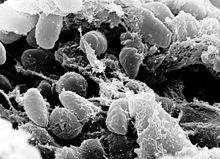Yersinia: Difference between revisions
m Simplify links and/or other minor fixes using AWB |
Squidonius (talk | contribs) →History: Rewritten |
||
| Line 45: | Line 45: | ||
==History== |
==History== |
||
{{for|other genera named after people|List of bacterial genera named after personal names}} |
|||
The genus is named after [[Alexandre Emile John Yersin|A.E.J. Yersin]], a Swiss [[bacteriologist]], who co-discovered the ''[[Yersinia pestis]]'' bacterium—the causative agent of the [[bubonic plague]] along with [[Kitasato Shibasaburō]]. The special genus ''Yersinia'' has been recognized since 1971, mainly for [[Taxonomy|taxonomic]] reasons.{{Citation needed|date=February 2007}} |
|||
{{also|Bacterial taxonomy}} |
|||
Yersinia pestis, the first described species, was identified in 1894 by [[Alexandre Emile John Yersin|A.E.J. Yersin]], a Swiss [[bacteriologist]], and [[Kitasato Shibasaburō]], a Japanese bacteriologist.<ref name=VL44>{{cite doi|10.1007/BF02272779}}</ref> It was formerly described as ''[[Pasteurella]] pestis'' (known [[Common name|trivially]] as the plague-bacillus) by Lehmann and Neumann in 1896.<ref name=VL44/><ref name=lpsn>{{lpsn|xz/yersinia.html|Yersinia}}</ref> In 1944, van Loghem reclassified the species ''P. pestis'' and ''P. rondentium'' into a new genus ''Yersinia''.<ref name=VL44/><ref name=lpsn/> Following the introduction of the Bacteriological code, it was accepted as valid in 1980<ref name=lpsn/><!--This last sentence is here as a misunderstood version was present previously --> |
|||
==References== |
==References== |
||
Revision as of 12:38, 16 May 2011
| Yersinia | |
|---|---|

| |
| Scientific classification | |
| Kingdom: | |
| Phylum: | |
| Class: | |
| Order: | |
| Family: | |
| Genus: | Yersinia van Loghem, 1944
|
| Species | |
|
Y. aldovae | |
Yersinia is a genus of bacteria in the family Enterobacteriaceae. Yersinia are Gram-negative rod shaped bacteria, a few micrometers long and fractions of a micrometer in diameter, and are facultative anaerobes.[1] Some members of Yersinia are pathogenic in humans; in particular, Y. pestis is the causative agent of the plague. Rodents are the natural reservoirs of Yersinia; less frequently other mammals serve as the host. Infection may occur either through blood (in the case of Y. pestis) or in an alimentary fashion, occasionally via consumption of food products (especially vegetables, milk-derived products and meat) contaminated with infected urine or feces.
Speculations exist as to whether or not certain Yersinia can also be spread via protozoonotic mechanisms, since Yersinia are known to be facultative intracellular parasites; studies and discussions of the possibility of amoeba-vectored (through the cyst form of the protozoan) Yersinia propagation and proliferation are now in progress.[2]
Microbial physiology
An interesting feature peculiar to some of the Yersinia bacteria is the ability to not only survive but actively proliferate at temperatures as low as 1-4 degrees Celsius (e.g., on cut salads and other food products in a refrigerator). Yersinia bacteria are relatively quickly inactivated by oxidizing agents such as hydrogen peroxide and potassium permanganate solutions.
Pathogenesis
Y. pestis is the causative agent of plague. The disease caused by Y. enterocolitica is called Yersiniosis.
Y. pseudotuberculosis sometimes but rarely causes disease.[citation needed]
Yersinia may be associated with Crohn's disease, an inflammatory autoimmune condition of the gut. Iranian sufferers of Crohn's disease were more likely to have had earlier exposure to refrigerators at home,[3] consistent with Yersinia's unusual ability to thrive at low temperatures.
Yersinia is implicated as one of the causes of reactive arthritis worldwide.[4]
Also associated with pseudoappendicitis, which is an incorrect diagnoses of appendicitis due to a similar presentation.[5]
History
Yersinia pestis, the first described species, was identified in 1894 by A.E.J. Yersin, a Swiss bacteriologist, and Kitasato Shibasaburō, a Japanese bacteriologist.[6] It was formerly described as Pasteurella pestis (known trivially as the plague-bacillus) by Lehmann and Neumann in 1896.[6][7] In 1944, van Loghem reclassified the species P. pestis and P. rondentium into a new genus Yersinia.[6][7] Following the introduction of the Bacteriological code, it was accepted as valid in 1980[7]
References
- ^ Ryan KJ; Ray CG (editors) (2004). Sherris Medical Microbiology (4th ed.). McGraw Hill. pp. 368–70. ISBN 0838585299.
{{cite book}}:|author=has generic name (help)CS1 maint: multiple names: authors list (link) - ^ Attention: This template ({{cite doi}}) is deprecated. To cite the publication identified by doi:10.1139/W08-039, please use {{cite journal}} (if it was published in a bona fide academic journal, otherwise {{cite report}} with
|doi=10.1139/W08-039instead. - ^ Attention: This template ({{cite pmid}}) is deprecated. To cite the publication identified by PMID 19177167, please use {{cite journal}} with
|pmid=19177167instead. - ^ Attention: This template ({{cite doi}}) is deprecated. To cite the publication identified by doi:10.1002/art.1780350613, please use {{cite journal}} (if it was published in a bona fide academic journal, otherwise {{cite report}} with
|doi=10.1002/art.1780350613instead. - ^ "EMedicine". Retrieved 2010-07-22.
- ^ a b c Attention: This template ({{cite doi}}) is deprecated. To cite the publication identified by doi:10.1007/BF02272779, please use {{cite journal}} (if it was published in a bona fide academic journal, otherwise {{cite report}} with
|doi=10.1007/BF02272779instead. - ^ a b c Yersinia in LPSN; Parte, Aidan C.; Sardà Carbasse, Joaquim; Meier-Kolthoff, Jan P.; Reimer, Lorenz C.; Göker, Markus (1 November 2020). "List of Prokaryotic names with Standing in Nomenclature (LPSN) moves to the DSMZ". International Journal of Systematic and Evolutionary Microbiology. 70 (11): 5607–5612. doi:10.1099/ijsem.0.004332.
External links
- Yersinia Enterocolitis Mimicking Crohn's Disease in a Toddler
- Sweden: Pork warnings over new stomach illness
- Yersinia genomes and related information at PATRIC, a Bioinformatics Resource Center funded by NIAID
